PinotFile: 6.27 May 28, 2007
|
Anderson Valley has Baul Hornin’ There are eleven grape-growing appellations in Mendocino County, California, but it is the Anderson Valley that is uniquely suited to growing that minx of a grape, Pinot Noir. Plantings of Pinot Noir in Mendocino County (1,930 acres) are overshadowed by other varietals such as Chardonnay (4,336 acres), Cabernet Sauvignon (2,559 acres), and Zinfandel (2,072 acres). The history of winegrowing in Mendocino County is linked most closely with Parducci (the oldest winery in the region dating to 1931) and Fetzer (dating to the late 1960s) who flooded the market through the years with wines of reliable value from the warmer areas of Mendocino County outside the bounds of the Anderson Valley. Anderson Valley has achieved its own notoriety through the production of super-premium artisan Pinot Noirs, crisp Alsatian whites (Riesling, Pinot Gris, and Gewürztraminer), and superb sparkling wines.
The Anderson Valley is a relatively isolated area bordered on two sides by 1000+ foot mountains and located 15 miles from the Pacific Ocean at its northern tip or “deep end.”. The valley floor is about 18 miles long and opens on its northern end to the Pacific coast via the Navarro River Canyon. This unique topography allows morning fog to roll into the valley and gentle breezes to enter in the afternoon. A gradient is created, with the northern ocean end, referred to by locals as “down-valley,” receiving more rain and fog and thus being cooler, and the southern inland portion, or “upper- valley” being typically 8-10° warmer. The valley’s vineyards and wineries are clustered along the fringes of Highway 128, which bisects the valley, with a majority of them located down-valley. Along Highway 128, the vineyards begin at the town of Boonville, continue north through Philo, and end in the tiniest hamlet of the three, Navarro (see map, page 2). Continuing north, Highway 128 travels a circuitous and twisting, but scenic, route to the Pacific Ocean.  Most visitors access the Anderson Valley via Highway 128 as it departs westward from Highway 101 at Cloverdale, 80 miles north of San Francisco. (Do not be confused by Highway 128 East which you approach first heading north that takes you to Guerneville). Once on Highway 128 West, you quickly enter a pastoral land of great beauty and your pulse seems to slow with each mile you travel (that is, if you don’t encounter a lumber truck coming south on the narrow two-lane highway!). You leave the world of roadside McDonalds and gas stops and encounter a countryside teaming with moss-covered majestic oaks, towering redwoods, ramshackle old barns, and calmly grazing sheep and cows. In 30 minutes you come to Yorkville, the town center of the Yorkville Highlands AVA, tucked between the Anderson Valley to the northwest and Alexander Valley to the southeast at the headwaters of the Russian River. There are 22 vineyards located here at higher elevations (most are between 1,000 and 2,200 ft) and planted primarily to red varietals including some Pinot Noir. Another 15 minutes of driving brings you into Boonville, the center of “activity” in the valley. About 3,000 people are scattered throughout the valley, a fourth of them calling Boonville home.  The Anderson Valley will never become another Napa Valley simply because retirees and urban refugees with money seeking the wine lifestyle won’t find the creature comforts here. In a recent article in Wine Enthusiast Online titled “The Price of Dirt”, authored by Roger Voss and Kathleen Buckley, a realtor who sells vineyard estates and wineries in Sonoma County (John Bergman) points out that “an essential factor in deciding where to buy is the restaurant scene. For the lifestyle, you have to have all the attributes, the finest restaurants, the finest wineries, and finest hotels. That rules out vineyards in marginal lifestyle areas, no matter how nice the trophy house.” Boonville has only three restaurants, a fine restaurant at the Boonville Hotel featuring California-style cuisine prepared by talented chef Johnny Schmidt, the Redwood Drive-In Café, and Libby’s, a small but popular Mexican restaurant. The gourmet restaurants of Mendocino and Fort Bragg are a 45 minute drive away. I was in a buffet line at a barbecue while recently visiting Anderson Valley, and stretching my neck to view the dessert table, I remarked, “There is only one dessert.” One of the locals turned around and said to me, “Hey, this is Mendocino, not Napa!).
Boonville is known as Boont in the local language of Anderson Valley called boontling. In the 1800s, an indigent and secretive code-like dialect became the spoken word for many of the valley residents. The exact origins are unclear, but many attribute the beginnings to the mothers and children who worked in the hop fields prevalent in the valley at the time. The isolation of the valley and the distrust of city people (“brightlighters”) fostered the language. Terms included “baul seep” (lovers of wine), “baul hornin’” (good drinking), “Frati” (wine - Mr Frati was a local vineyardist), Frati shams (wine grapes), “breggo” (sheep), and “backdated chuck” (someone who is behind the times). Many of the words had their origins in language of the Scottish, Irish, Spanish, and Pomo Indians (the original settlers of the valley). Today, fragments of boontling remain as slang terms. One word of caution if you visit: if you don’t want to incur the wrath of locals by appearing to be a raging brightlighter, leave your designer jeans, Louis Vitton bags, and Polo shirts at home. The Pomo tribe were the original Native American inhabitants of Anderson Valley. Among the first white settlers here in 1851 was the Anderson family. Walter Anderson planted the first apple trees in the valley. Soon, hop fields were ubiquitous and a thriving timber industry developed. The 1960s brought an influx of hippies drawn to the beauty and isolation of the valley. During the 1970s and 1980s, urban refugees bought ranches and replaced apple orchards with vineyards. The latest newcomers to the valley are Mexican laborers valued for their work in the vineyards. Olives are the newest crop and several olive oil producers including well-regarded Stella Cadente have appeared. In the late 1800s, Italian immigrants came to Mendocino from San Francisco and had success growing grapes above the valley along the Greenwood Ridge. In the 1940s and 1950s, attempts to grow grapes in the valley by Asti, Goodhue, and Pinoli were largely unsuccessful because of problems with ripeness and frosts. The modern history of winegrowing in the Anderson Valley is linked to four names: Edmeades, Husch, Lazy Creek and Navarro. In 1963. Dr. Donald Edmeades, a Pasadena, California cardiologist, purchased land north of Philo. He planted his first 24 acres in 1963. The locals were quite skeptical, and Edmeades, in good humor, put up a sign on Hwy 128 that read “Edmeades’ Folly.” He had, in fact, carefully researched the potential for grape growing in the valley. At the time, the University of California Davis viticulturalists had completed a survey of the valley and classified the lower valley between Philo and Navarro as Region I (the coolest for grape growing and the location of Edmeades) and the upper valley around Boonville as cool Region II. Edmeades had success growing Chardonnay and Gewürztraminer, but unfortunately, he passed away from cancer just after his winery was built in 1972. His son Deron took over and made the first vintage. Edmeades (now part of Kendall- Jackson and closed to the public), has achieved notoriety with Zinfandel grown in Mendocino County. Edmeades was never a major player in the Pinot Noir game. The first Pinot Noir planted in the Anderson Valley was by Husch Vineyards in 1968. Founder Tony Husch had been exposed to Pinot Noir by John Parducci. A 3-acre parcel of the estate known as The Knoll was chosen. Located on a hillside overlooking the Navarro River, it was planted to a Wente field selection. The first harvest was in 1971. Long-time vineyard manager, Al White, arrived in 1973. As Al recounts his first harvest at Husch in 1974, one is struck by the archaic vineyard management of the time. The vines were planted with 8 ft by 12 ft spacing with overhead irrigation. Trellising was minimal and no leaf pulling was done. Rain at harvest was a problem and with it came mold which was a significant nuisance. The grapes were picked to apple boxes at a very casual pace over several days by a hippie crew! The Knoll Vineyard is still producing Pinot Noir, but has been transfigured by more modern viticulture practices. The third noteworthy modern winegrowing pioneer in the Anderson Valley was a restaurateur from San Francisco, Johann Kobler and his wife Theresia. He purchased the 20-acre Lazy Creek Vineyards in 1969 from the Pinoli family who started a farm on the property in Philo in the early 1900s. Pinoli had the first bonded winery in the valley (1911). He showed that grapes could ripen here, but Pinoli had much more success with his fruit orchards than his vineyards. Kobler was able to revitalize the vineyards, built a small winery in 1973, and had success with both Pinot Noir and Gewürztraminer. Lazy Creek was purchased by Josh and Mary Beth Chandler in 1999 and they have carried on the tradition respectably. 9.5 acres of Pinot Noir are planted to multiple heritage and suitcase clones. (Pictured below are magnificent large oak vessels inside the tiny Lazy Creek Winery).  Ted Bennett was a successful businessman when he and his wife, Deborah Cahn, left San Francisco in 1973 and purchased a 900-acre sheep ranch along Highway 128 between Philo and Navarro. They were Alsatian grape aficionados and planted only white varietals initially beginning in 1974. Pinot Noir came later, and today they have 31 acres of estate Pinot Noir and source additional Pinot Noir from other Anderson Valley vineyards. It was largely their marketing sense that put Anderson Valley in the minds of wine enthusiasts. They built an attractive tasting room and sent out a very informative newsletter that led to considerable consumer-direct sales. Today, their lineup of quality wines is impressive and includes Gewürztraminer, Riesling, Sauvignon Blanc, Pinot Gris, Muscat, Zinfandel, Syrah, and Pinot Noir (3 bottlings including Anderson Valley, Méthode a l’Ancienne, and Deep End Blend). Today, there are 20 wineries and more than 60 vineyards in the Anderson Valley. Most of the vineyards are less than 10 acres, with three large growers, Roederer Estate, Goldeneye and Navarro having sizable vineyards and controlling the most total acreage. Pinot Noir acreage has dramatically increased since 1995 and now accounts for more than 50% of Anderson Valley’s planted vineyard acreage. Some of the most prominent vineyard names supply grapes to both Anderson Valley wineries and wineries in neighboring counties. The vineyards have become household words to pinophiles: Cerise, Demuth, Donnelly Creek, Ferrington, Hein, Lindt, Savoy, Toulouse and Wiley. A partial list of wineries accessing Anderson Valley Pinot Noir grapes includes Ant Hill Farms (Savoy), Adrian Fog (Savoy). Barnett (Savoy), Benovia (Savoy), Brogan Cellars (Morning Dew Ranch), Copain (Cerise, Dennison, Hacienda Secoya, Hein Family, Kiser), Elke Vineyards (Donnelly Creek), Hartford Court (Velvet Sisters), Ici/la Bas (Donnelly Creek), La Crema, Littorai (Cerise, Savoy, One Acre), MacPhail (Tolouse, Ferrington), Radio-Coteau (Savoy), Roessler Cellars (Savoy), Saintsbury (Cerise), Skewis (Demuth, Narrows - formerly Floodgate), Williams Selyem (Ferrington, Weir-Yorkville), Whitecraft (Morning Dew Ranch), Whitethorn (Demuth), and Woodenhead Vintners (Wiley, Morning Dew Ranch). In the next issue, Part II of the Anderson Valley report, profiles of all Anderson Valley Pinot Noir producers and an extensive tasting of Anderson Valley Pinot Noirs will be presented.
Anderson Valley Pinot Noir Festival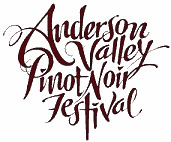
I attended the recent 10th Annual Anderson Valley Pinot Noir Festival held
on a sunny weekend May 18-20. The event originated 15 years ago with
winery open houses, but was formalized into a festival in 1997. The festival
has increased in popularity in step with the rise in quality of Anderson
Valley Pinot Noir over the last five years and this year’s celebration was
sold out with 650 people attending. Held the third weekend in May each
year, the festival is sponsored by the Anderson Valley Winegrowers Association.
Excerpts From The Technical ConferenceThe focus of this conference was the growing and making of Pinot Noir in the vineyards and wineries of the Pacific Coast and was hosted by Fred Buonanno of Philo Ridge. Glenn McGourty, winegrowing and plant science advisor for Lake and Mendocino Counties, presented some interesting statistics. From 1997 to 2005 the planted acreage of Pinot Noir in California increased from 10,000 acres to over 25,000 acres, with a little over 2,000 acres in Mendocino County. Sonoma County led the way with 10,027 acres, Monterey County was next with 4,102 acres, then Santa Barbara County with 3,169 acres, Napa Valley with 2,263 acres and finally Mendocino County. The average price paid per ton for Pinot Noir in Mendocino County varies from $500 to more than $3,000 with an average of $2,082 per ton. Santa Barbara County, fueled by the ‘Sideways’ phenomenon, leads the way at $2,670 per ton topping Sonoma County which demands $2,509 per ton.
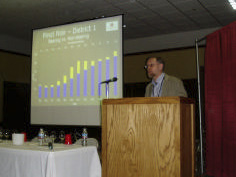 Bill Turrentine, a grape and wine broker, reported on the current state of the Pinot Noir trade. The overall statewide crush of Pinot Noir was 60,000 tons in 2002 compared with 100,000 tons in 2006. Despite this increase, the release of the movie ’Sideways’ led to a tight market for bulk Pinot Noir and currently demand is overtaking supply. Higher production of Pinot Noir is in the future, however, due to extensive new plantings particularly in relatively warm climate areas such as Lodi (Bronco Wines) and the importation of inexpensive bulk Pinot Noir from Italy and southern France. Turrentine expects the market to be flooded with under $20 Pinot Noir, while the $20 to $75 category will remain fiercely competitive. Inexpensive labels are operating on very thin margins at present, but are content to build their brand, figuring that as supply increases there will be a softening of grape prices and their wine will become more profitable in the future. Turrentine (pictured at podium), emphasized the need for more marketing dollars directed at promoting Pinot Noir as “fun and tasty, but not snobby,” particularly to the millennials (those born between 1978 and 2000, roughly 76 million in the U.S.) who are open to new things and seem attracted to Pinot Noir (below, at Londer Winery).
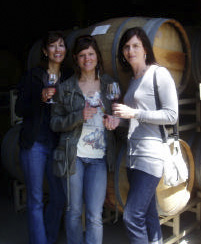 Ed Weber, viticulture farm advisor for Napa County shook up the many growers and winemakers in attendance with a talk on the dreaded vine mealybug and its relationship to virus leaf roll. Vine mealybug is a pest that has been identified in 17 counties including the Coachella and Central Valleys, Central and North Coasts and the Sierra Foothills. There is extensive infestation in Carneros where the wind spreads the bug widely. At this time, the vine mealybug has not been identified in the Anderson Valley, but a related species, the grape mealy bug has appeared.
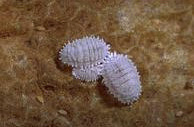 Although not a threat to the vine and grapes, it carries and spreads virus leaf roll. Leaf roll produces the red colored leaves seen in vineyards in the fall. The result is delayed grape maturity and decreased pigment in the grapes. The vine mealybug is about one-eight of an inch in size and is covered with white mealy wax. In cooler weather, it hides behind the bark of the trunk of the vine and even underground on the roots. As the weather warms, the mealybug can be found on cordons and the canopy and eventually all parts of the vine. The vine mealybug secretes honeydew that is a substrate for black sooty mold and in addition, the pest can infest the grape bunches making the grapes inedible. The bugs can also transmit vine viruses. Biological control has had some success including ant control (ants destroy the natural parasites of the mealybug). One of the common methods of spread is by picking bins which are freely exchanged between wineries.
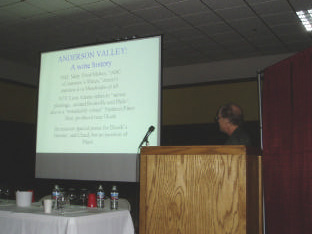 Steve Heimoff, West Coast Editor of Wine Enthusiast Magazine, spoke about his routine of tasting wines with emphasis on Pinot Noir during his 15 year tenor at the publication. He pointed out that six cool climate counties in California account for more than 90% of all Pinot Noir. He summarized the alluring flavors of Pinot Noir as fruity notes (cherries, berries, plum), earthy notes (pomegranate, rhubarb, licorice, mushroom, cocoa, beet), barrel notes (toast, vanillin, spice), and a touch of funk. Heimoff tastes over 4,000 wines a year under controlled circumstances at his offices where he has a consistent routine and surroundings. He prefers not to taste wines at wineries because the presence of the winemaker and the winery milieu influence his opinion (the so-called "cellar palate"). A considerable number of wines are sampled and never reviewed in the Wine Enthusiast because of poor quality. His personal palate prefers the more Old World or traditional style of Pinot Noir, believing that the high alcohol in many newer Pinot Noirs creates a hot, dense and sweet wine that distorts typicity. Despite the high alcohol, however, "some Pinots get away with it." What he looks for primarily are typicity (the typical taste and texture of Pinot Noir) and balance. One conclusion he has reached after tasting thousands of Pinot Noirs is that clones, rootstock and soil type don’t seem to matter all that much as greatness in Pinot Noir can result from any number of combinations of clones, rootstock and soil type. Dr. Doug Adams, Professor of Viticulture at University of California Davis discussed tannins and tannin assay in Pinot Noir. In researching 48 vineyard sites in California, he found a wide range in the amount of tannin in skins and seeds. He concluded that site has more influence on tannin levels than clones or rootstocks. He also found that knowing the amount of tannin at harvest cannot be used to predict the quantity of tannin in the finished wine. Steve Pitcher, a noted wine writer, asked if the tannin level of the finished wine could be added to wine labels as a guide to one’s tasting experience. Dr. Adams felt this was ill-advised as many other factors such as acid levels in the wine in combination determine the perception of tannin (astringency) in the finished wine. The session wrapped up with a tasting and presentation by winemakers Zach Rasmussen of Goldeneye and Jerome Chery of Saintsbury. They attempted to answer the question, “Which factor has the greater influence on wine character - the vineyard or the winemaker?” They swapped grapes from each other’s vineyards, picked on the same day in 2006. Saintsbury randomly selected three tons of grapes from the Brown Ranch Vineyard and Goldeneye did the same from their Confluence Block 9 and in turn sent three tons back to Saintsbury. Each winemaker also made wine from their own vineyard. They used different sized fermenting bins, different lengths of cold soak, different yeasts, and different cooperage. Barrel samples of each of the four wines were offered for tasting. The discussion that followed was quite spirited and many dissenting opinions were offered by the audience. No significant conclusion resulted but the winemakers promise to carry on the experiment for future interest.
Grand TastingOn Saturday, May 19, the Grand Tasting was held in the middle of the estate vineyard at Goldeneye. There was a carnival atmosphere under the big tent as 34 participating wineries poured both their latest releases of Pinot Noir and library wines of past vintages. The sun was out, the air was brisk and clear, and the smell of barbecue wafted freely throughout the grounds. A silent auction was held to benefit four local charities and many wine luminaries were in attendance. A large colorful poster, designed by artist Gerald Reis of Design Studio in Cloverdale, was made to commemorate the event and was prominently displayed. (see page 8 of this issue's print version).
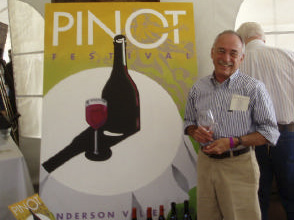 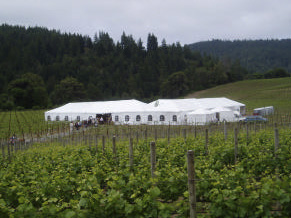 One of the highlights of the Grand Tasting for me was the opportunity to meet and chat with Burt Williams, formerly winemaker and co-owner of Williams Selyem. Burt now resides in the Anderson Valley on his 40-acre property and farms his own 12.5 acre Morning Dew Ranch Pinot Noir Vineyard. He seems quite pleased with the opportunity to grow his own grapes (he never owned a vineyard while at Williams Selyem) which he sells to his daughter Margi of Brogan Cellars (pictured with Burt’s wife), Woodenhead Vintners, and Whitcraft. When asked if he planned to make his own Pinot Noir again, he was noncommittal. He did say, however, with a twinkle in his eye, if he does decide to make a Morning Dew Ranch Pinot Noir “he will make very small quantities and it will be very expensive!”
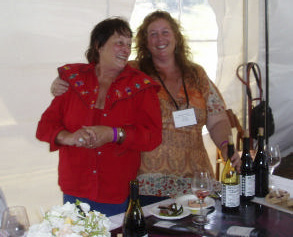 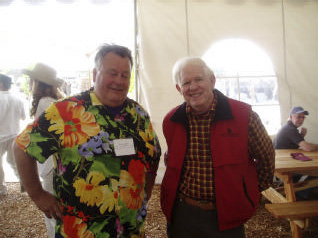 There were a number of outstanding Pinot Noirs I tasted but an event like this is more a celebration and social occasion than a serious tasting venue. I was able to meet old friends and make many new contacts and indoctrinate my wife, Patti, in the routine of walk-around tastings. Suffice it say, that the quality from some producers was astonishingly good, and even less striking examples were of perfectly fine breeding. In next week’s issue, I will present the results of my extensive tasting of Pinot Noirs from most of the participants and more.
Winemaker Dinners
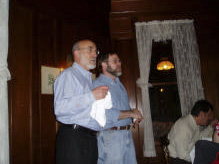 A number of special dinners were hosted by wineries at notable restaurants on the Mendocino Coast. I attended a very special one at Rendezvous Inn and Restaurant in Fort Bragg featuring the Pinot Noirs of Breggo Cellars, Londer Vineyards and Standish Wine Company. The restaurant is located in the living room of a historic residence built in 1897 by Herbert Baum, the town’s apothecary. Located 10 minutes north of the town of Mendocino, the restaurant has been rated #1 by Zagat Guide for food in Mendocino since 2004. Chef Kim Badenhop (pictured right with Larry Londer on the left next page) departed the business world to train as a chef in Europe. Upon returning to the United States, he became the chef at the venerable Café Beaujolais in Mendocino. In 1995, he bought the Rendezvous. He is a master of matching food and wine and each of the presented courses made the wines shine. This was one of the best and most ambitious wine dinners I have EVER had! I highly recommend a special trip to visit. Rendezvous has 6 rooms as well, priced nicely at $89 per night including a gourmet breakfast. The address is 947 N Main St. Fort Bragg, the phone is 1-800-491-8142, and the website is www.rendezvousinn.com.
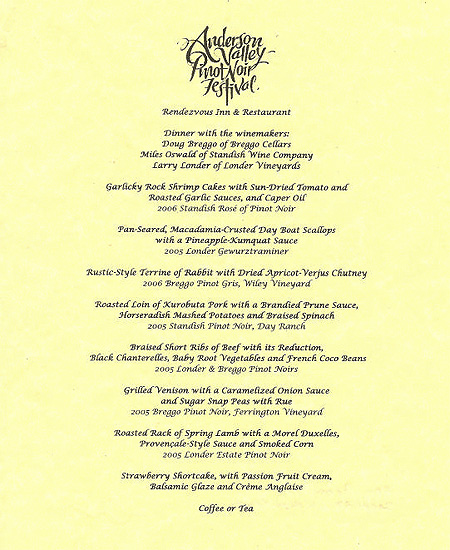
Stop Hiding and Start Living with Pinot NoirDo you have feelings of inadequacy? Do you suffer from shyness? Do you sometimes wish you were more assertive? If you answered yes to any of these questions, ask the Prince about Pinot Noir. Pinot Noir is the safe and natural way to feel better and more confident about yourself and your actions. Pinot Noir can ease you out of your shyness and overcome any obstacles. Pinot Noir will let you show the world you are ready to do almost anything. Shyness and awkwardness will become a thing of the past. Discover the many talents you never knew you had. You will notice the benefits of Pinot Noir almost immediately. A regimen of regular doses of Pinot Noir will allow you to live life the way you want to. Stop hiding and start living with Pinot Noir. Caution: Pinot Noir is not for everyone. Women who are pregnant or nursing should not use Pinot Noir, but women who wouldn’t mind being pregnant or nursing are encouraged to try it. Side Effects: Loss of money, loss of clothing, loss of virginity, loss of motor control, desire to dance like a retard or perform table dancing, heightened erotic lustfulness, may cause pregnancy, may make you think you can play all-night strip poker, may make you think you can sing, may give you the illusion you are tougher, stronger or better looking than others, may make you think ex-lovers are dying for you to call them at 4 o’clock in the morning, may give you the illusion that people are laughing with you, and may be a factor in getting your butt kicked. So what are you waiting for? Stop hiding and start living with Pinot Noir!
Anderson Valley Websiteswww.avwines.com: Anderson Valley Winegrowers Association www.MendoWine.com: Mendocino Winegrape and Wine Commission www.andersonvalley.org: Anderson Valley homepage www.andersonvalleychamber.com: Anderson Valley Chamber of Commerce www.avbc.com: Anderson Valley Brewing Company - good site for news, events, businesses Note: Do not confuse Anderson Valley, California with Anderson Valley Vineyards which is located in Albuquerque, New Mexico and owned by Patty Anderson.
Wine 101A glass of red wine might counteract the damage from advanced glycation end products (AGEs) generated when foods are barbecued. |